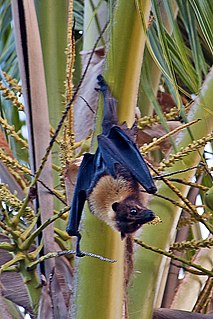The Pittsburgh Rebels were a Major League Baseball club based in Pittsburgh, Pennsylvania in 1914 and 1915. The team was a member of the short-lived Federal League.They finished the 1914 season as the Pittsburgh Rebels. The team was originally called Pittsburgh Stogies after an earlier Pittsburgh team that played in the Union Association in 1884. They finished the year as the Pittsburgh Rebels. The team played all of its home games at Exposition Park, located on Pittsburgh's Northside. The Pittsburgh Pirates of the National League left the stadium for Forbes Field in 1909. After the Rebels left Exposition Park in 1915, the field was demolished and its property became part of the rail yards.
The Samoa sawtooth eel, Serrivomer samoensis, is a sawtooth eel of the genus Serrivomer, found in the southwest Pacific at depths between 500 and 2,000 m. Their length is up to 75 cm.
Ichthyoallyeinotoxism, or hallucinogenic fish inebriation, comes from eating certain species of fish found in several parts of the tropics, the effects of which are reputed to be similar in some aspects to LSD. Experiences may include vivid auditory and visual hallucinations. This has given rise to the collective common name "dream fish" for ichthyoallyeinotoxic fish.
The Samoan white-eye is a species of bird in the family Zosteropidae. It is endemic to the island of Savai'i in Samoa.

The Samoa flying fox or Samoan flying fox is a species of flying fox in the family Pteropodidae. It is found in American Samoa, Fiji, and Samoa. Its natural habitat is subtropical or tropical dry forests. It is threatened by habitat loss.

The mao or ma'oma'o is a passerine bird belonging to the genus Gymnomyza in the honeyeater family Meliphagidae. It is an endangered species and is endemic to the Samoan Islands.
Solfia is a rare, monotypic genus of flowering plant in the palm family endemic to Samoa, where the only known species is Solfia samoensis.
Macaduma is a genus of moths in the subfamily Arctiinae.
Monosyntaxis is a genus of moths in the family Erebidae. The genus was erected by Swinhoe in 1901.
Hemiliostraca is a genus of sea snails, marine gastropod mollusks in the family Eulimidae.
Monosyntaxis bipunctata is a moth of the family Erebidae. It was described by George Thomas Bethune-Baker in 1904. It is found in New Guinea, where it is found in mountainous areas, particularly the Central Mountains. It is also found in Papua New Guinea.
Monosyntaxis persimilis is a moth of the family Erebidae. It was described by Walter Rothschild in 1912. It is found in New Guinea, where it is distributed in mountainous areas in the central part of the island, up to the Wandammen Mountains in the west. It is also found in Papua New Guinea.
Monosyntaxis bimaculata is a moth of the family Erebidae. It was described by Rob de Vos in 2009. It is found in New Guinea, where it has only been recorded from the Foja Mountains.
Monosyntaxis affinis is a moth of the family Erebidae. It was described by Walter Rothschild in 1912. It is found on Peninsular Malaysia and Java.
Monosyntaxis holmanhunti is a moth of the family Erebidae. It was described by George Hampson in 1914. It is found on Peninsular Malaysia, Borneo, Java and Bali.
Monosyntaxis montanus is a moth of the family Erebidae. It was described by Schulze in 1910. It is found on Luzon in the Philippines.
Monosyntaxis ochrosphena is a moth of the family Erebidae. It was described by Wileman and West in 1928. It is found on Luzon in the Philippines.
Monosyntaxis trimaculata is a moth of the family Erebidae. It was described by George Hampson in 1900. It is found on Borneo. The habitat consists of upper montane forests.

Acropora samoensis is a species of acroporid coral found in the Red Sea, the Gulf of Aden, the southwest and northern Indian Ocean, the central Indo-Pacific, Australia, Southeast Asia, Japan, the East China Sea and the oceanic west and central Pacific Ocean. It occurs in tropical shallow reefs on upper slopes of reefs, from depths of 5 to 15 metres. It was described by Brook in 1891.
The Lithosiina are a subtribe of lichen moths in the family Erebidae.





